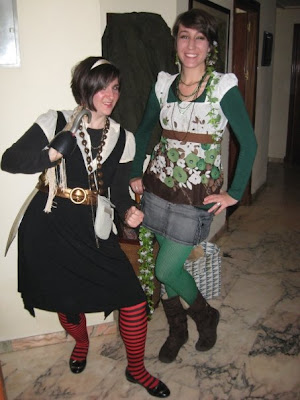
CRAZY BUSH ROOM
You can see that the weather was kinda not so good, but I Picasa'd the pictures to make them look more like they felt (yay for the saturation option!). Past the gardens and in the summer palace is the Patio de la Acequia, which is absolutely gorgeous.
PATIO DE LA ACEQUIANext is the Jardin de la Sultana, which is striking because of the sheer noise of the water, and which has a 700 year old cypress tree in it where some sultan supposedly found his lover cheating on him.
JARDIN DE LA SULTANA FROM THE TOP. YOU CAN SEE JUST HOW MANY FOUNTAINS THERE ARE
Next, we walked back to the main boy of the Alhambra to go to the Palace of Carlos V and the spectacular Palacio Nazaries. I don't know if I can even really describe the Palacio Nazaries. Its described as the most brilliant Islamic building in Europe. What gets me is that the palace as it is now is not even close to what it was – its very well preserved, but when you see the intricate plasterwork that makes up all the walls you have to imagine it all painted in bright colors, and all the pictures I took of windows filled with intricate woodwork have to be imagined with colored glass filling all the holes. All the light that came in those rooms was richly colored, as were all the walls. I can't even imagine how spectacular it was.

THIS IS THE SORT OF THING THAT COVERS ALL THE WALLS

THE DELICATE COLUMNS OF THE PATIO DE LOS LEONES. THERE ARE 124 COLUMNS IN THIS PATIO ALONE. THE FOUNTAIN ITSELF IS NORMALLY SUPPORTED BY 12 MARBLE LIONS, WHICH ARE BEING RESTORED RIGHT NOW. LEGEND HAS IT THAT WATER WOULD COME OUT OF A DIFFERENT LION'S MOUTH EACH HOUR OF THE DAY
When we were done with our tour I felt like I wasn't really very done with the Alhambra yet, and luckily some friends decided to join me to go back through the Jardines del Generalife. I'm glad we did because the sun came out a bit and they were even more beautiful with a bit of light on them. There's nothing quite like that in the states – check out my pics on picasaweb (www.picasaweb.google.com/chameleon021) and maybe you'll get a better idea.....Granada was amazing.



+011.jpg)
+009.jpg)
+037.jpg)
+051.jpg)
+058.jpg)



+064.jpg)